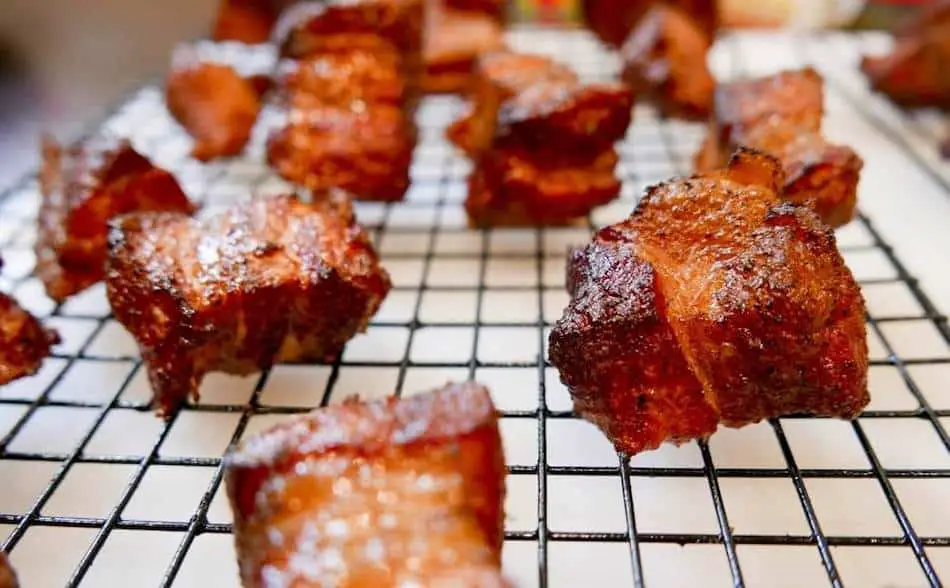
Pork Belly Burnt Ends are one of the most delicious appetizers you will ever make in your Traeger pellet grill. The next time you’re asked to bring something to a barbecue, a tray of this ‘meat candy’ will make you the star of the party. Pork Belly Burnt Ends are easy to prepare and you could finish the entire process within 3-hours. I wanted to become a master of this dish, so asked some pitmasters how they smoke this pork deliciously using a Traeger or pellet smoker.
Key Points
- Pork Belly Burnt Ends are a delicious appetizer made using a Traeger pellet grill.
- To make Pork Belly Burnt Ends, buy a whole pork belly from your butcher with a good ratio of meat and fat.
- Cut the pork belly into 2×2 inch cubes and remove the skin, then apply a barbecue rub or seasoning of your choice to the cubes.
- Let the rub sit for at least 15 minutes and place the cubes on an airing rack before smoking.
- Smoke the pork cubes in the Traeger pellet grill at a temperature of 225-250 degrees for around 2-3 hours, or until the internal temperature reaches at least 185 degrees.
- Once finished, the meat will be caramelized and tender with a smoky flavor, making a perfect appetizer for parties.
- To make own seasoning, Basic homemade seasoning includes a mix of kosher salt, pepper, garlic powder, onion powder, chilli powder, and brown sugar, Recommended rubs are Harry Soo’s championship rubs or BBQ Guru Malcolm Reed’s killer Hogs rubs, Check the video provided to make own rub recipe.
What are Pork Belly Burnt Ends?
Pork belly burnt ends are a barbecue dish that originated in the United States, specifically in the barbecue regions of Texas and Kansas City. The dish is made from the pork belly, the same cut of pork used to make bacon.
The name “burnt ends” refers to the crusty, caramelized edges of the meat that are traditionally cut from the point end of a smoked beef brisket and cooked further. In the case of pork belly, the cubes are cut from the belly and cooked until the edges become crispy and caramelized.
The best meat for pork belly burnt ends is meat with a good ratio of fat and meat, as the fat gives the dish a lot of its flavor.
Pork belly burnt ends have many variations. Some recipes call for a dry rub while others call for a marinade or a glaze. They can be cooked on a variety of grills, including a Traeger pellet grill, a traditional smoker, or a barbecue pit.
Pork belly burnt ends are often served as an appetizer, although they can also be enjoyed as a main course. They are easy to cook, although they require some time and attention to get the perfect crust and tenderness.
Pork Belly Burnt Ends Recipe
| Recipe for Pork Belly Burnt Ends |
|---|
| Ingredients |
| – Whole pork belly (10-12 pounds) |
| – BBQ Rub or seasoning of your choice (Kosher salt, pepper, garlic powder, onion powder, chilli powder, brown sugar) |
| – Airing rack or spare grill grate |
| Instructions |
| 1. Buy a whole pork belly from your butcher and have the skin removed. Select a belly with a good ratio of meat and fat. |
| 2. Cut the pork belly into 2×2 inch cubes, removing any excess fat and skin. |
| 3. Apply a BBQ Rub or seasoning of your choice to the pork cubes, making sure it covers every cube. Let the rub sit for at least 15 minutes, or even overnight in a zip-lock bag. |
| 4. Place the pork cubes on an airing rack or spare grill grate. |
| 5. Set your Traeger pellet grill to a temperature of 225-250 degrees and smoke the pork cubes for 2-3 hours or until the internal temperature reaches at least 185 degrees. |
| 6. Once finished, the meat will be caramelized and tender with a smoky flavor, perfect for serving as an appetizer. |
Why are Burnt Ends so Popular?
Pork belly burnt ends are popular for a few reasons:
- Flavor: Pork belly has a high fat content which results in a rich and flavorful meat when cooked properly. The smoking process adds a deep smoky flavor, and the addition of a dry rub or sweet glaze creates a complex and delicious taste that people find irresistible.
- Texture: Pork belly burnt ends have a unique texture that is both tender and slightly crisp. They are succulent, juicy, and have a rich, porky flavor that makes them a tasty treat.
- Versatility: Pork belly burnt ends can be served in a variety of ways, they can be used in sandwiches, salads, tacos, and as appetizers, allowing for different presentations and variety of flavors.
- BBQ culture: Barbecue culture has grown in popularity in recent years, and pork belly burnt ends are a staple in the BBQ world. Pitmasters and home cooks have been experimenting and perfecting the process of making these burnt ends and this had also an influence on their popularity.
- Social Media: With the rise of social media and food-related platforms, many people have been introduced to pork belly burnt ends and other BBQ dishes and this helped to spread the word about this delicious dish. People want to try it out for themselves and share it with others, and the positive word of mouth has contributed to their popularity.
Can You Make Pork Belly Burnt Ends on a Pellet Grill
Pellet grills use wood pellets as a fuel source, which creates a smoky flavor similar to that of a traditional smoker.
To make pork belly burnt ends on a pellet grill, you’ll need to follow a similar process as you would with a traditional smoker.
- First, prepare your pork belly by trimming off any excess fat, and cutting it into 1 to 1 1/2 inch cubes.
- Season your pork belly cubes with a dry rub or marinade of your choice. Allow the pork belly to sit in the seasoning for at least an hour or up to overnight to absorb the flavors.
- Preheat the pellet grill to 225-250F. Set it to the smoke setting for an hour.
- Smoke the pork belly cubes on the pellet grill for about 4-6 hours, or until the internal temperature of the meat reaches 203°F, or your desired level of doneness.
- After that, the pork belly cubes are removed from the grill and tossed in a sweet and sticky sauce. Return them to the grill to finish cooking. This step can be done in 20-30 minutes or until the sauce is caramelized and sticky.
- Rest your pork belly burnt ends for 10-15 minutes before serving.
It’s important to keep an eye on the temperature of the grill and the internal temperature of the meat. also, be aware that different types of pellets can give different flavors to the meat, you can experiment with different types of wood pellets to find the one that you like the most.
1. Buy a Whole Pork Belly
Pork burnt ends are made from the pork belly, the same cut of pork used to make bacon. To make Pork Belly Burnt ends, you will need to buy a whole pork belly from your butcher. Have the skin removed if possible, otherwise you can skin the meat yourself once you get home and cook the crackling separately.
Select a belly with a good ratio of meat and fat. The thing that makes this appetizer so delicious is the fat, but you want a bit of meat on there as well.
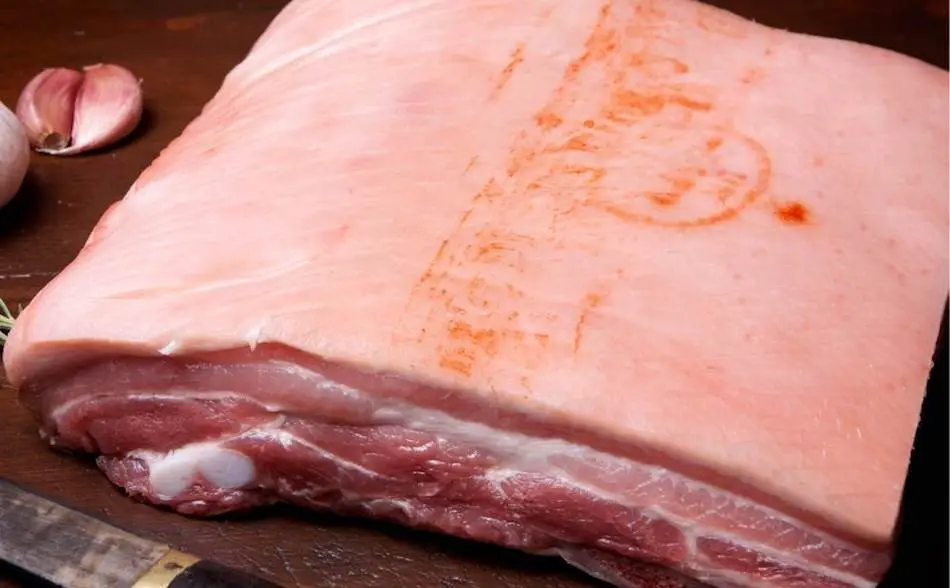
2. Cut The Pork Belly Into 2 x 2 Inch Cubes
You can buy pork belly that has already been cut into long strips. To turn pork strips into burnt ends, all you need to do is remove the skin on each strip, then cut them into cubes. If you buy pork belly strips, make sure they are about 2 inches thick otherwise they won’t make good burnt ends.
Cutting the belly yourself will give you full control over the size. You will need to allow for shrinkage, so make the cubes 2 inches by 2 inches. A whole belly should weigh between 10-12 pounds and cost $30 -$40. A whole belly will make enough burnt ends for a large gathering, but most recipes call for 2-5 pounds of pork belly.
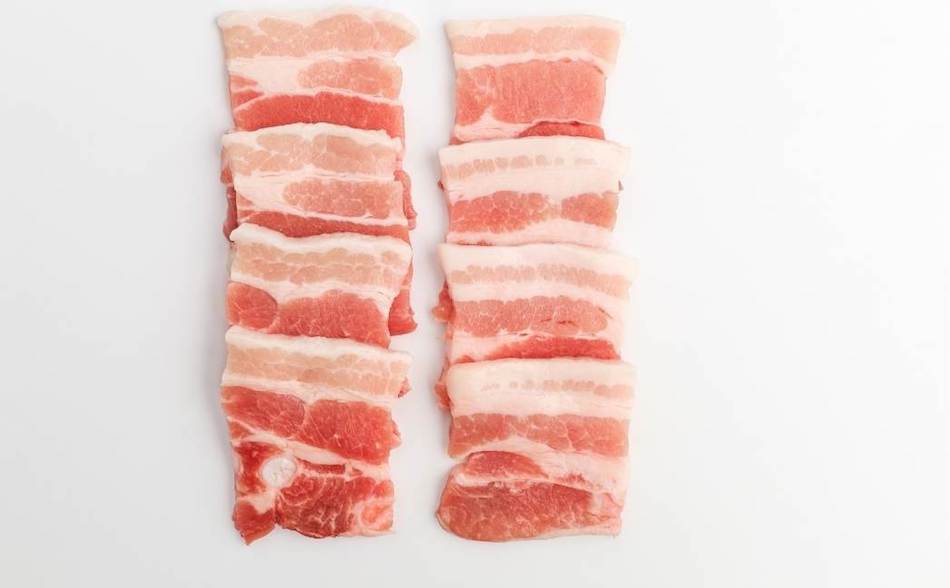
How To Prepare Pork Belly For Burnt Ends
- Remove the skin from the belly, because the smoke and flavor can’t penetrate the rind.
- Trim the pork belly, removing any excess fat.
- Slice the pork belly into strips, then cubes. I’ve heard people cut one by one-inch cubes, but most pitmasters go bigger with two by two-inch cubes to allow for shrinkage (see video below for demonstration).
3. Apply a Barbecue Rub to the Pork Cubes
Once you’ve cut the pork belly into cubes, apply a decent covering of your favorite pork rub or whatever seasoning you prefer. If you like chilli powder, this is when to mix it in. Make sure the rub and seasoning cover every cube of pork, so it has a nice coating. Once you have applied the rub, let it sit for at least 15-minutes, but longer is better. Some people place the pork cubes in a zip-lock bag overnight to allow the rub to penetrate the meat.
“How to Smoke Brisket Burnt Ends Like a Pro”
What’s the Best Rub for Pork Belly Burnt Ends?
There are a number of good pre-made rubs on the market, and I can recommend barbeque competitor Harry Soo’s championship rubs here, or BBQ Guru Malcolm Reed’s Killer Hogs rubs here. Sweet always goes well with pork, so add some brown sugar if that’s your preference.
If you prefer to make your own seasoning rather than used a store-bought rub, a basic homemade seasoning includes a mix of:
- Kosher salt
- Pepper
- Garlic powder
- Onion powder
- Chilli powder
- Brown sugar
The best rub recipe I have found, check the video below posted on How To BBQ Right. I use this recipe on all my meats, but alter the ingredients for my own liking. This recipe is a good foundation to make any rub and can be altered for specific meats. For pork, I add in more sugar, but for beef I add in less sugar. This recipe contains lots of spice, so I only use about 1/4 of the chilli, paprika and cayenne pepper.
4. Place Pork Cubes on an Airing Rack
Before you put the pork cubes into the Traeger, make life easier for yourself by using an airing rack rather than placing each individual cube onto the Traeger grill grate. If you lay the pork cubes directly onto the grill on your smoker, you’re going to have a hard time transferring the meat, and the lid to your pellet grill will be open for too long causing massive temperature swings. If you don’t have an airing rack, just use a spare grill grate that can fit inside your Traeger. Otherwise, buy an airing rack from a cookware store or on Amazon here.
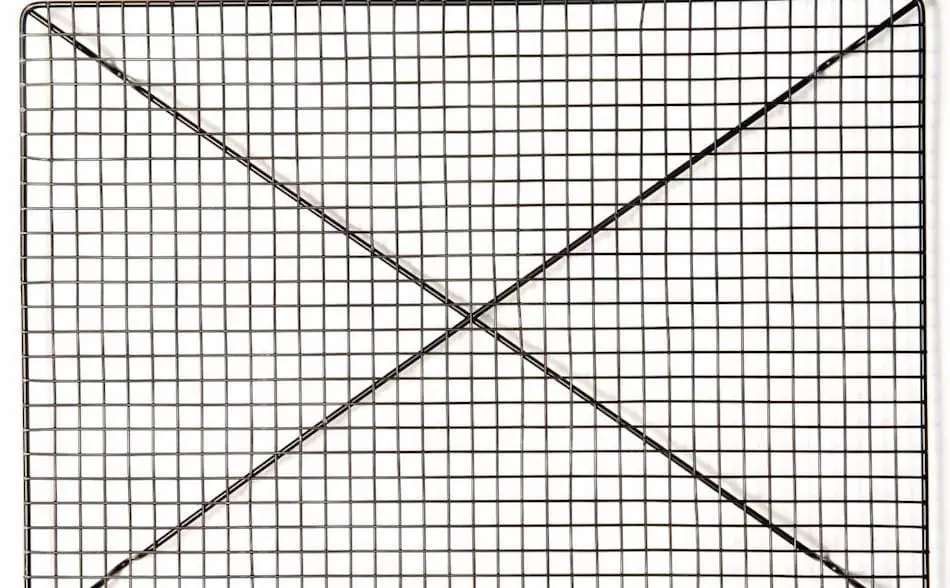
5. Set The Traeger Between 250°F and 275°F
The best temperature for pork belly burnt ends is between 250°F and 275°F. Some pitmasters start lower, in the 180°F range, to allow more time for the pork to absorb smoke flavor, and this is something you can experiment with. We don’t want to cook our pork belly too high because we want to give the fat on the belly a chance to melt. The low-and-slow temperature is very important so we can get the right chewy texture.
6. Add Smoking Wood
Choose any wood that blends well with pork such as apple or cherry. You can use a stronger wood like hickory or mesquite if you like bold smoke flavors. Wood choice is like rub choice, it all comes down to individual taste preference. Experiment with wood until you find the right flavor profile.
- Oak is a popular choice because it provides a strong, smoky flavor that complements pork well.
- Pecan wood is considered by many pitmasters to be the best wood for smoking pork, as it has a mild, nutty flavor that doesn’t overpower the meat.
- Cherry wood is a popular choice among pitmasters because it gives pork a slight fruity and sweet taste.
- Apple wood is also considered as one of the best option for smoking pork for its mild and fruity flavors.
- Maple, also liked for its sweetness and mild flavor.
| Wood Type | Flavor Profile |
|---|---|
| Apple | Mild and fruity |
| Cherry | Mild and fruity with a hint of sweetness |
| Pecan | Nutty and slightly sweet |
| Oak | Bold and smoky |
| Maple | Mild and slightly sweet |
| Peach | Mild and slightly sweet |
7. Smoke the Pork Cubes for 1.5 Hours
Place the airing tray with the pork belly cubes into the Traeger and cook for about 1.5 hours. Open the lid and check the pork cubes, and they should have dried and have a reddish color depending on your rub. Pitmasters do varying things at this point; some will spritz with apple juice or apple cider vinegar, others will place them in an aluminium pan and add butter.
Either way, the pork should nearly be done at this stage, so they need to be monitored carefully. Check them every 30-minutes until the cubes are tender. You can probe them with an instant-read thermometer and look for an internal temperature of around 200°F, or you can gauge the doneness by probing and feel. Once they are done, remove the rack from the grill.
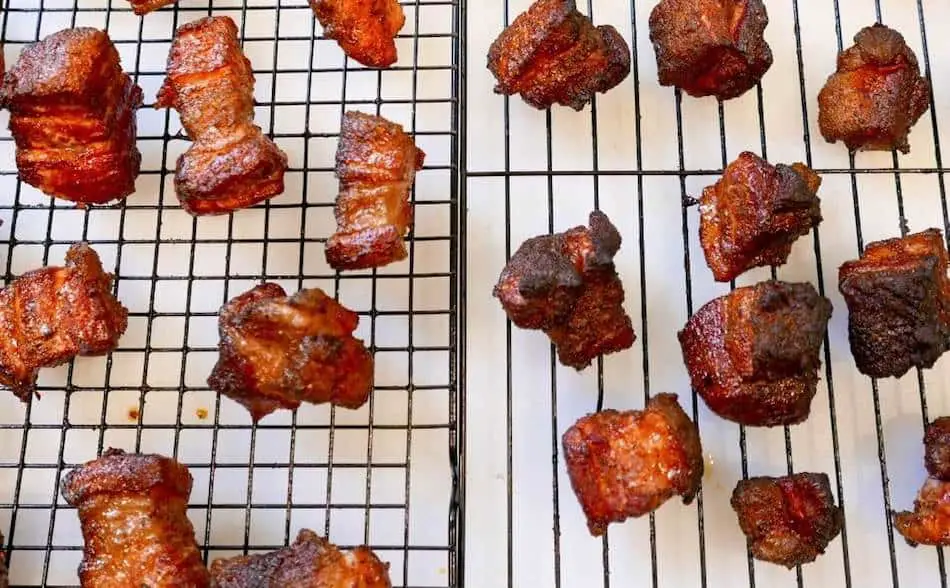
8. Apply Barbecue Sauce to the Pork Belly
The last stage of the cook is applying the glaze. Pork belly burnt ends are often served with a variety of sauces to add extra flavor and moisture to the meat. Some popular sauce options for pork belly burnt ends include:
- BBQ sauce: A classic choice, traditional BBQ sauce is made with a combination of tomato, sugar, and vinegar, and it’s a great option for adding a sweet and tangy flavor to the meat.
- Mustard sauce: A mixture of yellow mustard, brown sugar, and apple cider vinegar is a popular choice for pork belly burnt ends that add tangy and sweet flavors.
- Coffee BBQ sauce: this sauce uses coffee as an ingredient and its perfect to give a rich, smoky and intense flavor to the pork.
- Hot sauce: spicy hot sauce can be a good addition to bring extra heat to the meat and make it extra tasty
- Honey-based sauces: honey, maple, or agave mixed with herbs, spices and sometimes mustard to give a touch of sweetness to the pork.
- Remove the pork belly cubes from the airing rack and place them in an aluminium pan.
- Apply some more rub and nearly every recipe will drizzle honey onto the cubes in this final stage of the cook because sweetness is key to this barbecue dish.
- The next step is to add a barbecue sauce into the tray and mix it all around until it coats every pork cube in sauce. As with the rub, people use all kinds of different barbecue sauces for the glaze. So add your favorite barbecue sauce. I like to use the same barbecue sauce I use with pork ribs.
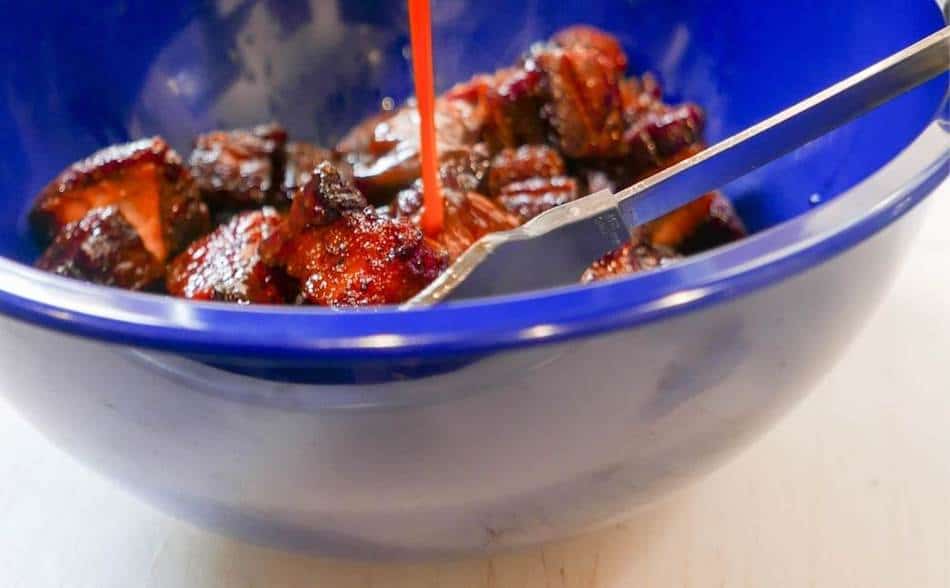
The 4 Best Barbecue Sauces For Burnt Ends
- Sweet Baby Ray’s Honey Chipotle Barbecue Sauce (see here)
- Stubb’s Original Bar-B-Q Sauce (see here)
- G Hughes Smokehouse BBQ Sauce (see here)
- Rufus Teague Whiskey Maple BBQ Sauce (see here)
9. Cook for Another 15 Minutes to Set the Glaze
The last step is to set the glaze by placing the tray back into the Traeger for a short stint. Once you have placed the pork cubes into a tray and added the sauce, place the pork belly back into the smoker for 15-25 minutes. After 15-minutes, the glaze should have set and caramelized, giving the pork belly burnt ends the chewy, sticky texture that we are all trying to achieve.
About the Pork Belly
Pork belly is a fatty cut of pork, taken from the abdomen of a pig. It contains a 50/50 fat to meat ratio, which is why it has so much flavor. Pork belly is used to make bacon, and is extremely popular in Asian cooking.
When buying pork belly for smoking burnt ends, there are a few things to consider to ensure that you get the best quality meat:
- Look for a consistent thickness: A consistent thickness in the pork belly will ensure that the meat cooks evenly and provides consistent results.
- Check for marbling: Pork belly should have a good amount of marbling, which is the white lines of fat running through the meat. This will ensure that the meat is moist and flavorful when it’s cooked.
- Inspect the skin: The skin of the pork belly should be thick, tight and even. This will help ensure that the meat is flavorful and juicy.
- Quality of the Meat: Try to buy your pork belly from a trusted butcher or a reputable meat supplier, if you can’t inspect the meat yourself make sure to get it from a trusted source.
- Look for a fresh meat: You want to avoid meat that has an off odor or a slimy texture, or that has discoloration, any of this signs could mean that the meat is not fresh.
- Size: Pork bellies come in different sizes, make sure to adjust the cooking time and temperature based on the size of the pork belly you are using.
How to Serve Pork Belly Burnt Ends
- Smoked baked beans
- Coleslaw.
- Salad.
- Smoked sweet potatoes
- Mac and cheese
- Mashed Potatoes
- Cornbread
- Vegetables
How Long Does it Take to Cook?
| Cut of Pork | Cook Time (Hours) | Cook Temperature (F) | Internal Temperature (F) |
|---|---|---|---|
| Pork Belly Burnt Ends | 4-6 | 225-250 | 203 |
Please note that the cook times and temperatures provided are approximate and can vary depending on the size of the pork belly and the type of smoker being used. Additionally, the internal temperature of the pork is the most important thing to make sure is at safe eating level.
The USDA recommends that pork should be cooked to an internal temperature of 145°F (63°C) with a 3 minutes rest time before consuming.
It’s also important to note that for pork belly burnt ends, the process usually starts by seasoning the belly and then smoking it for several hours to achieve the desired smoky flavor and to cook it through.
After that, it is cut into cubes and returned to the smoker with a dry rub or a sweet and sticky glaze, that should be added at the end of the smoking process to caramelize and add more flavor.
The Best Wood for Pork According to the Experts
Aaron Franklin, the owner and pitmaster of Franklin Barbecue in Austin, Texas, uses a variety of woods for his barbecue. According to him, he primarily uses post oak wood for smoking pork. This is because post oak wood is abundant in the central Texas area and it has a mild and slightly sweet flavor that pairs well with pork. Additionally, post oak burns hot and long, which makes it ideal for smoking meats like pork that require a longer cook time. Also, post oak has low resin content and doesn’t create a heavy smoke that can overwhelm the pork.
Additionally, he sometime use pecan wood as well, which have a similar characteristics of post oak but have a bit more nuttiness, sweetness and complexity to the meat.
Meathead Goldwyn, the founder and pitmaster of AmazingRibs.com, is a well-known expert on barbecue and grilling. According to him, hickory and oak are the best woods to use for smoking pork. Both woods are strong and flavorful, and pair well with the rich taste of pork. Additionally, hickory and oak burns hot and long, which makes it ideal for smoking meats like pork that require a longer cook time.
Hickory, in particular, is known for its strong, smoky flavor that complements the rich taste of pork. It is also used for a bacon-like flavor. On the other hand, Oak is a milder wood that also burns hot and long. It provides a nice sweetness to meat and it also balance out the strong smoky taste of hickory.
Meathead also suggested to avoid using mesquite wood for smoking pork, as its strong flavor can overpower the taste of the pork.
Harry Soo, owner of Slap Yo’ Daddy BBQ and a barbecue competition winner, recommends using fruitwood such as apple, cherry, peach, or plum to smoke pork. These woods are known for having a mild and sweet flavor that complements the taste of pork and adds a nice fruity undertone. These woods also burns hot and slow, which is perfect for low and slow smoking of meats.
Harry Soo also recommend using pecan wood for pork. Pecan wood is known to produce a mild and nutty smoke that complements the taste of pork, without overwhelming it. Additionally, Pecan wood has a high heat output and burns for a long time and it has a nice sweetness that goes well with pork.
It’s worth noting that different pitmasters have different preferences when it comes to wood choices and it may also depend on where you live and the wood availability as well. Experimenting with different wood types to see which one you like best is always a good idea.
Chris Lilly, Executive Chef and pitmaster of Big Bob Gibson BBQ, recommends using hickory and oak for smoking pork. Both woods are known to be strong, flavorful woods that complement the rich taste of pork. Additionally, hickory and oak burns hot and long which is perfect for low and slow smoking of meats.
Hickory in particular, is known for its strong, smoky flavor that complements the rich taste of pork. Oak wood also is a good choice because of it is a milder wood, yet it burns hot and long, provides a nice sweetness to meat and it also balance out the strong smoky taste of hickory.
Chris Lilly also recommend using fruit woods, such as apple and cherry, for smoking pork. These woods are known for having a mild and sweet flavor that complements the taste of pork and adds a nice fruity undertone.
It’s worth noting that different pitmasters have different preferences when it comes to wood choices and it may also depend on where you live and the wood availability as well. Experimenting with different wood types to see which one you like best is always a good idea, and it’s always better to try different combination of woods to find what you like best.
My Favorite Meat Smoking Tools
Thanks for checking out this article. I hope you learned a few things. Here are some of my favorite tools I use when smoking brisket that may be useful to you. These are affiliate links, so if you decide to purchase any of these products, I’ll earn a commission. But in all honesty, these are the tools I recommend to my family and friends who are just starting out.
Meat Thermometer: There are dozens of fancy thermometers on the market, but I still use my trusty TP20. For around $50, I have a high-quality meat thermometer with two probes, and can track the temperature of my smoker with one probe, and my meat with the other probe. The ThermoPro TP20 is an Amazon Best Seller because it’s the easiest thermometer to operate, is durable, highly accurate, and comes with pre-programmed meat settings.
Instant Read Thermometer: Arguably, the second most important tool you need is a fast and accurate instant-read thermometer. These tools play an important role in the latter stages of the cook when the meat needs regular checking in multiple areas. I use the ThermoPro TP19 because it can do everything a ThermaPen can do, but for a fraction of the cost. You can check out the TP19 on Amazon here.
Wireless Thermometer: The latest thermometers on the market have no wires and can be controlled by wi-fi via your phone. Airprobe 3 is the best of this technology.
Butcher Paper: Wrapping brisket in butcher paper has become a huge trend in barbeque thanks to Aaron Franklin. Wrapping your brisket in paper will give you a nice brisket bark. However, you can’t just use any old paper, it has to be unwaxed, food grade paper. You can find it on Amazon here.
Advanced Thermometer and Automatic Temperature Controller: Once you’re ready to take things seriously, the FireBoard 2 Drive is a six-channel Bluetooth/Wi-Fi thermometer that can monitor up to 6 pieces of meat, control and graph your cook sessions on your smartphone, and attaches to an an automatic blower that will convert your charcoal smoker to a set-and-forget. This is one of the most advanced meat thermometers on the market. You can check it out on the FireBoard website here.
